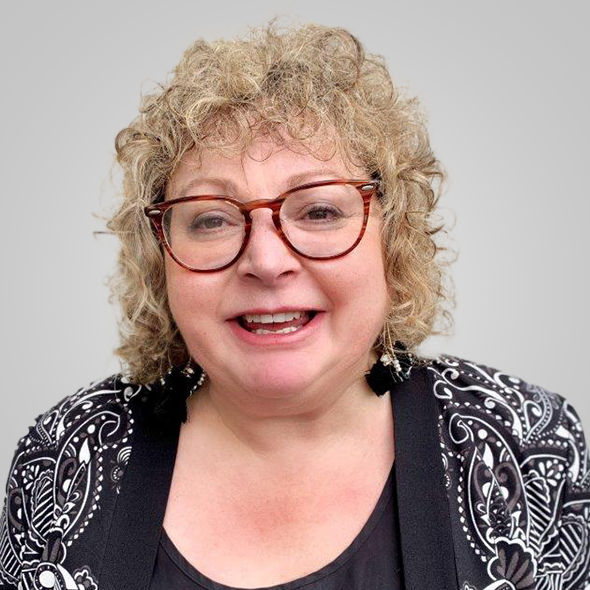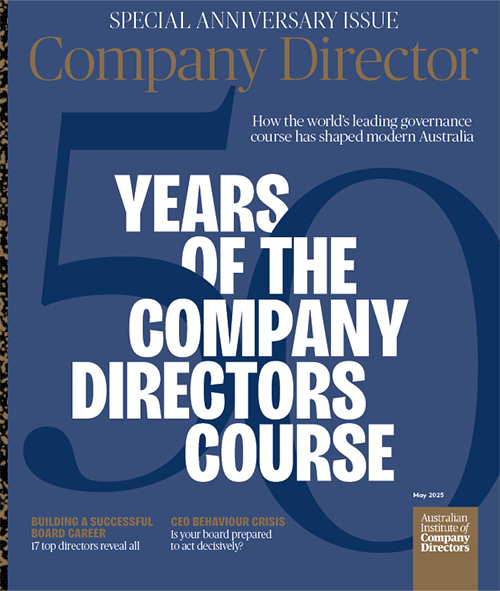Australian organizations have taken significant strides in prioritising physical work, health and safety. It’s important for boards to bring the same level of focus and oversight to psychosocial risks.
Understanding psychosocial risks, or the elements that create a risk of psychological harm in the workplace, is the new frontier of work health and safety (WHS) and there’s no quick fix in managing them, says Tony Morris, a director of SafeTM. He explains the duty to manage psychosocial risks in the context of WHS has existed since the 1980s. “However, the safety regulators back then were not investigating or prosecuting for this risk — they were only responding to physical risk.”
Since then, he says we’ve seen the evolution of the WHS legislation following increasing reports of bullying, harassment and rising workplace demands and stress in the wake of the #MeToo movement.
Rush of regulatory changes
Dr Katrina Sanders GAICD, chief medical officer at Aspen Medical, says Safe Work Australia amended the WHS regulations in July 2022 to formally recognise psychosocial hazards as risks that need to be eliminated or minimised so far as is reasonably practicable.
Separate to WHS law, the Sex Discrimination Act 1984 (Cth) was amended following the release of the Respect@Work report in March 2020. Further to this, notes Sanders, a positive duty was introduced in December 2022 requiring organisations to proactively take steps to eliminate workplace sexual harassment and a broader range of harmful behaviours, rather than waiting for incidents to occur before taking action. “This goes beyond responding to complaints,” she says.
Morris notes that while there is consistency generally, each state, territory and the Commonwealth have different model WHS laws and ways of responding to psychosocial risks. Some have instituted regulations. Others have developed codes of practice or guidance.
Most recently, the Queensland government introduced new requirements to the Work Health and Safety Regulation 2011 (Qld) that make it clear workplaces must be proactive in preventing sexual harassment. Carolyn Grant GAICD, CEO of People Plus Science, says these include having a preventative plan by March 2025 and also outline additional director duties and penalties.
Although Victoria has yet to introduce a code for managing psychosocial hazards, there have been discussions that may result in increased positive duty requirements and reporting for organisations of a particular size, adds Grant.
Questions directors should ask about psychosocial risks
Is the board up to speed with our psychosocial hazard obligations?
Which of the psychosocial hazards are most critical to our organisation and how are they being assessed, controlled and reported on?
What new steps are we taking to improve our psychosocial culture, including training and mental health support for managers and staff, and effective reporting channels?
Are there any emerging psychosocial risks — for example, from operational changes, how we work or the technology we use?
Are we tracking early warning indicators such as sick leave trends, turnover, workload perceptions and stress-related claims?
Have we signed off on psychosocial hazard reports as part of our minutes and governance processes?
State of play
Grant’s research has found that many boards don’t understand the psychosocial risks in their organisations or the effectiveness of remedial activities.
“Very few have evaluated their strategies for continual improvement or have a clear strategy for managing and eliminating psychosocial hazards,” she says. “Unfortunately, with 25 per cent of employees saying they take their frustrations out on customers, clients or consumers, this is not good for the organisations surveyed.”
According to Ashurst WHS partner Trent Sebbens, a survey by his firm in November 2023 found over 50 per cent of companies had taken no steps — or didn’t know what steps had been taken — to eliminate or mitigate psychosocial risks in their organisations. “Since then, we’ve certainly seen organisations paying more attention to psychosocial risks and control measures,” he says. “Similar to the regulators, employers are feeling their way through this, learning from each other and on the ground from the things that are going well or could be improved.”
However, he notes many organisations are still in the early stages of dealing with psychosocial risks. “At the moment, the focus is probably on compliance, but you’d hope over time that will move towards proactive steps to engage employees and change the culture of workplaces generally.”
Sebbens says employers are at different stages of the journey, depending on their size, sophistication and industry.
“Some industries have been the focus of inquiries or investigations into psychosocial hazards or workplace harassment in the past, which has perhaps led them to take quicker steps than others. Also, the maturity of organisations in managing safety overall has fed into how quickly they've taken progressive steps to counter psychosocial risks.”
Morris’ research shows that blue-collar workforces have generally moved faster than white-collar ones. “They are used to managing safety risk,” he says. “White-collar organisations haven’t had to exercise that muscle as much and are taking a bit longer.”
He cautions organisations not to see psychosocial risks as such a big issue that they don’t do anything.
“They get stuck in the mud thinking it’s all too hard. In fact, it’s like eating an elephant — you must start somewhere,” he says, stressing that regulatory scrutiny and prosecutions are on the rise.
Psychosocial hazards at work:
Job demands
Low job control
Poor support
Lack of role clarity
Poor organisational change management
Inadequate reward and recognition
Poor organisational justice
Traumatic events or material
Remote or isolated work
Poor physical environment
Violence and aggression
Bullying
Harassment, including sexual and gender-based harassment
Conflict or poor workplace relationships and interactions.
The challenges
Sanders says one of the biggest challenges in addressing psychosocial hazards is that many are cultural and systemic, rather than isolated events.
“Harassment, bullying and work-related stress often persist in environments where poor behaviour is normalised, leadership capability is inconsistent and reporting mechanisms are either unclear or lack credibility,” she says. “Fear of reprisal is a significant barrier. Many employees still don’t feel psychologically safe to speak up. There’s also a widespread lack of confidence among managers to recognise and respond to early warning signs, particularly in high-pressure or remote environments.”
While important, Sanders says anonymous reporting is not a substitute for culture. “Organisations need both effective systems and cultural permission to speak up. The goal should be creating an environment where staff do not feel the need to be anonymous in the first place.”
Relying on reactive, incident-based approaches to psychosocial risk limits early detection and strategic oversight. Sanders advocates shifting from lag indicators to real-time data. Lead indicators such as absenteeism trends or exit interviews should be tracked, rather than relying solely on complaints or compensation claims.
Grant cautions against taking a one-size-fits-all approach to mitigation and elimination. “Every team will be different, consisting of different personalities and roles.”
Strategies that work well
According to People Plus Science CEO Carolyn Grant, these psychosocial risk mitigation strategies are paying off for companies:
Prioritising actions according to the psychosocial hazards with the largest impacts
Team-based strategies addressing high impacts
Strong leadership that genuinely cares about people and performance
Skills development in communication and conflict resolution
Specific programs and workplace campaigns targeting vulnerable cohorts.
Combined effort
Traditionally, psychosocial issues were considered HR matters and dealt with on a complaint basis, says Sebbens. Organisations must now take a longer-term, systems-based safety approach, adjusting it to deal with psychosocial risks. However, not all traditional approaches to dealing with physical risks will apply.
“On the ground, it requires HR and WHS teams to come together to ensure they’re taking a combined and holistic approach to dealing with psychosocial risks and hazards,” he says. “But from a governance and oversight perspective, the board can play a significant role. Firstly, it should set the tone on psychosocial risk and foster a culture of compliance and ethical conduct in the workplace. Then, with executive teams, the board should develop clear communications about what behaviours are expected on the ground and what should be disparaged. The leadership should back its words with meaningful action so that, for example, there is consistent enforcement of workplace behaviour standards and policies. There should also be accountability for non-compliance and assurances that passive permission is not given to inappropriate behaviour.”
Psychosocial risks in the boardroom
According to Grant, firstly, boards need to ensure they have identified any psychosocial risks in the board and executive team to ensure they are not the problem. In her research, she asks directors about the emotions they bring into the boardroom. Worryingly, 40 per cent say they feel anxious or fear intimidation. Some are conflicted about remaining on a board because of its dynamics.
Grant identifies various causes of director stress, including misalignment of strategy, mistrust and personal agendas instead of organisational concerns and lack of clarity around roles and responsibilities. The chair may not facilitate differences of opinion well, a few directors may dominate the conversation or directors may be concerned about rising spending on legal and compliance concerns.
She notes directors may also feel anxious if the board doesn’t operate as a team with management or if they don’t feel valued. Plus, there’s stress around asking questions or voting opposite to certain directors. Grant adds her 2025 Boardroom Psychological Safety Index (Australia) found a large perception gap between non-executive directors and executives, with over 50 per cent of NEDs “not sure” how their executives feel about boardroom psychological safety.
“This suggests those boards have not conducted psychosocial assessments and pose a large risk for their organisations,” says Grant. “Our recommendation is to close that gap. Psychosocial risks can go undetected by the chair and unless they trust the environment, many directors won’t speak up if they feel psychologically unsafe. Directors can also bring many of their external stressors into the boardroom. Conflict at the top is felt by every employee right to the bottom.”
This article first appeared under the headline 'Hazard reduction’ in the May 2025 issue of Company Director magazine.
Latest news
Already a member?
Login to view this content



